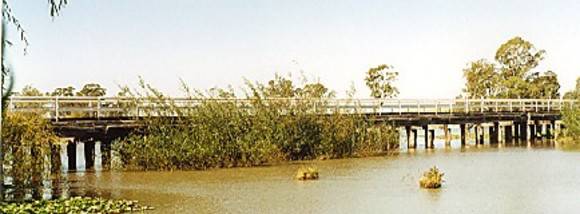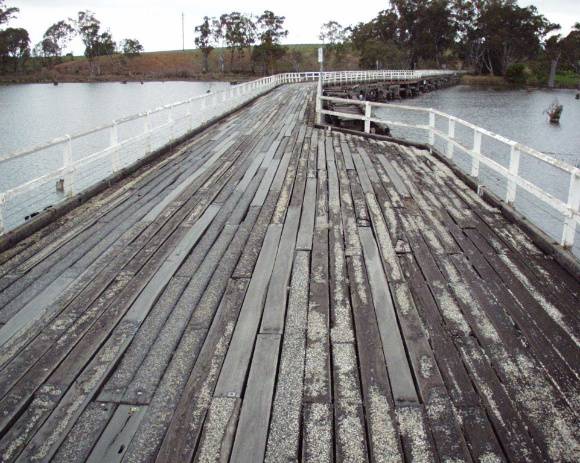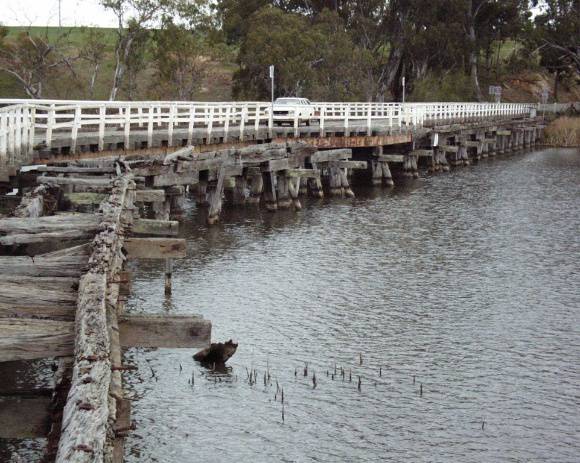| Back to search results » | Back to search page » |
|
Kirwans Bridge
LocationLobbs Road,, KIRWANS BRIDGE VIC 3608 - Property No B6846
File NumberB6846LevelState |
|
Statement of Significance
Opened in 1890, Kirwans Bridge is historically, scientifically, socially and aesthetically significant at the State level. Kirwans Bridge has a uniquely-angled and exceptionally-long timber deck with occasional passing bays. It is, with the Barwon Heads Bridge, equally the longest timber road bridge in Victoria, and retains its original forty-eight spans measuring sixteen and a half feet (5 metres), with its original seven main river-channel spans of thirty-three feet (10 metres), giving a deck length of approximately 308 metres. Original timber stringers were replaced in the 1950s by steel joists. Its original tall timber-trestle piers are largely immersed under Lake Nagambie and its ageing timber deck has been narrowed for one-way traffic, with only the passing bays extending the full twenty one feet (6.3 metres) width of the original deck.
Full timber side-rails still accentuate a dramatic mid-stream change in bridge direction, and two passing bays for motorists, that set Kirwans apart from other Victorian timber briges. Very few of Victoria's surviving timber road bridges can claim earlier origins, and none can claim a greater length of timber deck and side rails. Kirwan's Bridge also provides remarkable examples of engineering adaptation to changing vehicle needs over more than a century.
Kirwans is scientifically important as one of only two extant Victorian timber briges retaining vestiges of a colonial "strutted-corbel" type of river-bridge design. It was initially planned to be a fully strutted-corbel bridge: a style only occasionally used in earlier Victorian bridge construction. Only at Kirwans Bridge and the Jeparit Bridge is it now possible to study real examples of this historic European form of timber-bridge craftmanship. Although its visual effect is not greatly different from that of the equally rare and historic "strut-and straining-piece" design of nearby Chinamans Bridge, the structural detail and mechanics of the stringer-support system are structuraly different.
It gains in importance from being one of a unique group of four large timber road bridges from the 1890s, of contrasting types, located on the Goulburn River between Seymour and Murchison; and its construction was a direct result of Alfred Deakin's dream of a great "National" irrigation system based upon the construction of the Goulburn Weir.
Socially, Kirwans Bridge has always provided, and still does provide, a highly-valued amenity to those who live to the west of the Gouburn River but depend on Nagambie for basic services. So significant was this social role in the mid-1950s, that a threat to the bridge's continuing future led to a municipal sucession movement that enlarged the Shire of Goulburn at the expense of Kirwans' original builders, the Shire of Waranga. The current narrowed timber deck with passing bays, supported by rolled steel jousts placed over the ancient piers, remains a memorial to that municipal protest.
Kirwans Bridge's unusual passing bays on a relatively low-level timber bridge provide a significant temptation to fishermen, as well as a magnificent viewing platform from which to enjoy the broad clear waters of Lake Nagambie. It is within easy driving distance of Melbourne.
Aesthetically, Kirwan's Bridge remains a handsome and predominantly-timber structure that continues to provide tourist access to Lake Nagambie, Whroo ironbark forest and historic mining areas like Bailieston and Whroo.
Classified: 06/11/1998
Group
Transport - Road
Category
Road Bridge






